Performance of Cu/ZnO/Al2O3 Catalysts Prepared by Sol–Gel Methods on Methanol Steam Reforming
Abstract
:1. Introduction
2. Experimental Section
2.1. Preparation Processes
2.2. Material Characterization
2.3. Experimental Process
3. Results and Discussion
3.1. Characterization Results
3.2. Effect of Calcination Temperature on Catalytic Performance
3.3. Effect of Cu Loading on Catalytic Performance
3.4. The Citric Acid to Metal Ions Molar Ratio (CA/M) and pH
3.5. Effect of Al/(Cu+Zn) on Catalytic Performance
3.6. Comparison with Commercial Catalysts
3.7. Reaction Condition Optimization
4. Conclusions
Author Contributions
Funding
Data Availability Statement
Conflicts of Interest
References
- Singh, J.; Nozari, H.; Herreros, J.M.; Tsolakis, A. Synergies between aliphatic bio-alcohols and thermo-chemical waste heat recovery for reduced CO2 emissions in vehicles. Fuel 2021, 304, 121439. [Google Scholar] [CrossRef]
- Madeira, J.G.F.; Oliveira, E.M.; Springer, M.V.; Cabral, H.L.; do Carmo Barbeito, D.F.; Souza, A.P.G.; da Silva Moura, D.A.; Delgado, A.R.S. Hydrogen production from swine manure biogas via steam reforming of methane (SRM) and water gas shift (WGS): An ecological, technical, and economic analysis. Int. J. Hydrogen Energy 2021, 46, 8961–8971. [Google Scholar] [CrossRef]
- Ishaq, H.; Dincer, I.; Crawford, C. A review on hydrogen production and utilization: Challenges and opportunities. Int. J. Hydrogen Energy 2022, 47, 26238–26264. [Google Scholar] [CrossRef]
- Wei, Q.S.; Zhang, X.; Oh, B.S. The effect of driving cycles and H2 production pathways on the lifecycle analysis of hydrogen fuel cell vehicle: A case study in South Korea. Int. J. Hydrogen Energy 2021, 46, 7622–7633. [Google Scholar] [CrossRef]
- Lian, H.Y.; Liu, J.L.; Li, X.S.; Zhu, X.; Weber, A.Z.; Zhu, A.M. Plasma chain catalytic reforming of methanol for on-board hydrogen production. Chem. Eng. J. 2019, 369, 245–252. [Google Scholar] [CrossRef]
- Tang, L.; Kuai, L.; Li, Y.; Li, H.; Zhou, Y.; Zou, Z. ZnxCd1−xS tunable band structure-directing photocatalytic activity and selectivity of visible-light reduction of CO2 into liquid solar fuels. Nanotechnology 2017, 29, 064003. [Google Scholar] [CrossRef]
- Yong, S.T.; Ooi, C.W.; Chai, S.P.; Wu, X.S. Review of methanol reforming-Cu-based catalysts, surface reaction mechanisms, and reaction schemes. Int. J. Hydrogen Energy 2013, 38, 9541–9552. [Google Scholar] [CrossRef]
- Han, Z.; Tang, C.; Sha, F.; Tang, S.; Wang, J.; Li, C. CO2 hydrogenation to methanol on ZnO-ZrO2 solid solution catalysts with ordered mesoporous structure. J. Catal. 2021, 396, 242–250. [Google Scholar] [CrossRef]
- Liu, X.; Hong, H.; Zhang, H.; Cao, Y.; Qu, W.; Jin, H. Solar methanol by hybridizing natural gas chemical looping reforming with solar heat. Appl. Energy 2020, 277, 115521. [Google Scholar] [CrossRef]
- Wang, J.J.; Han, Z.; Li, C.; Chen, S.; Tang, C.; Sha, F.; Tang, S.; Yao, T. Liquid sunshine methanol. Chem. Ind. Eng. Prog. 2022, 41, 1309–1317. [Google Scholar]
- Simon Araya, S.; Liso, V.; Cui, X.; Li, N.; Zhu, J.; Sahlin, S.L.; Jensen, S.H.; Nielsen, M.P.; Kær, S.K. A Review of The Methanol Economy: The Fuel Cell Route. Energies 2020, 13, 596. [Google Scholar] [CrossRef]
- Xu, X.; Shuai, K.; Xu, B. Review on Copper and Palladium Based Catalysts for Methanol Steam Reforming to Produce Hydrogen. Catalysts 2017, 7, 183. [Google Scholar] [CrossRef]
- Zhu, J.; Araya, S.S.; Cui, X.; Sahlin, S.L.; Kær, S.K. Modeling and Design of a Multi-Tubular Packed-Bed Reactor for Methanol Steam Reforming over a Cu/ZnO/Al2O3 Catalyst. Energies 2020, 13, 610. [Google Scholar] [CrossRef]
- Zhang, Z.; Chen, X.; Kang, J.; Yu, Z.; Tian, J.; Gong, Z.; Jia, A.; You, R.; Qian, K.; He, S.; et al. The active sites of Cu-ZnO catalysts for water gas shift and CO hydrogenation reactions. Nat. Commun. 2021, 12, 4331. [Google Scholar] [CrossRef]
- Shen, Q.; Cai, Z.; Shao, Z.; Yang, G.; Li, S. Improved performance of bimetallic oxides CuO-Y2O3 synthesized by sol-gel for methanol steam reforming. J. Am. Ceram. Soc. 2022, 105, 6839–6850. [Google Scholar] [CrossRef]
- Cao, A.; Wang, Z.; Li, H.; Elnabawy, A.O.; Nørskov, J.K. New insights on CO and CO2 hydrogenation for methanol synthesis: The key role of adsorbate-adsorbate interactions on Cu and the highly active MgO-Cu interface. J. Catal. 2021, 400, 325–331. [Google Scholar] [CrossRef]
- Li, Y.; Luo, C.; Xu, J.; Su, Q. A cold start-up method with combining chemical-looping combustion and catalytic combustion for a methanol reformer. Int. J. Hydrogen Energy 2023. [Google Scholar] [CrossRef]
- Huang, T.; Qiu, Z.; Hu, Z.; Lu, X. Novel method of preparing hierarchical porous CoFe2O4 by the citric acid-assisted sol-gel auto-combustion for supercapacitors. J. Energy Storage 2021, 35, 102286. [Google Scholar] [CrossRef]
- Kowalik, P.; Antoniak-Jurak, K.; Próchniak, W.; Wiercioch, P.; Konkol, M.; Bicki, R.; Michalska, K.; Walczak, M. The Evaluation of Synthesis Route Impact on Structure, Morphology and LT-WGS Activity of Cu/ZnO/Al2O3 catalysts. Catal. Lett. 2017, 147, 1422–1433. [Google Scholar] [CrossRef]
- Shi, L.; Zeng, C.; Jin, Y.; Wang, T.; Tsubaki, N. A sol-gel auto-combustion method to prepare Cu/ZnO catalysts for low-temperature methanol synthesis. Catal. Sci. Technol. 2012, 2, 2569–2577. [Google Scholar] [CrossRef]
- Velinov, N.; Petrova, T.; Genova, I.; Ivanov, I.; Tsoncheva, T.; Idakiev, V.; Kunev, B.; Mitov, I. Synthesis and Mossbauer spectroscopic investigation of copper-manganese ferrite catalysts for water-gas shift reaction and methanol decomposition. Mater. Res. Bull. 2017, 95, 556–562. [Google Scholar] [CrossRef]
- Jha, A.; Jeong, D.W.; Jang, W.J.; Lee, Y.L.; Roh, H.S. Hydrogen production from water–gas shift reaction over Ni–Cu–CeO2 oxide catalyst: The effect of preparation methods. Int. J. Hydrogen Energy 2015, 40, 9209–9216. [Google Scholar] [CrossRef]
- Fornari, A.C.; Menechini Neto, R.; Lenzi, G.G.; dos Santos, O.A.A.; de Matos Jorge, L.M. Utilization of Sol-Gel CuO-ZnO-Al2O3 catalysts in the methanol steam reforming for hydrogen production. Can. J. Chem. Eng. 2017, 95, 2258–2271. [Google Scholar] [CrossRef]
- Tuza, P.V.; Manfro, R.L.; Ribeiro, N.F.; Souza, M.M. Production of renewable hydrogen by aqueous-phase reforming of glycerol over Ni–Cu catalysts derived from hydrotalcite precursors. Renew. Energy 2013, 50, 408–414. [Google Scholar] [CrossRef]
- Li, Y.S.; Luo, C.H.; Su, Q.Q. Cold start-up study of methanol reformer based on chemical-looping combustion. Fuel 2022, 317, 12850. [Google Scholar] [CrossRef]
- Wang, L.-B.; Wang, H.-H.; Zhang, L.; Qing, S.-J.; Liu, D.-M.; Gao, Z.-X.; Zhang, H.-J.; Guan, G.-Q. Effect of citric acid content on the hydrothermal synthesis of CuO/Ce0.8Zr0.2O2 catalytic water gas shift hydrogen production performance. J. Fuel Chem. Technol. 2022, 50, 337–345. [Google Scholar]
- Yang, B.; Deng, W.; Guo, L.; Ishihara, T. Copper-ceria solid solution with improved catalytic activity for hydrogenation of CO2 to CH3OH. Chin. J. Catal. 2020, 41, 1348–1359. [Google Scholar] [CrossRef]
- Mateos-Pedrero, C.; Azenha, C.; Tanaka, D.A.P.; Sousa, J.M.; Mendes, A. The influence of the support composition on the physicochemical and catalytic properties of Cu catalysts supported on Zirconia-Alumina for methanol steam reforming. Appl. Catal. B-Environ. 2020, 277, 119243. [Google Scholar] [CrossRef]
- Kong, X.-Q.; Tang, X.-J.; Xu, S.; Wang, X.-L. Preparation of CuO-ZnO/Al2O3 by Sol-gel Auto-combustion Method and Its Catalytic Property for Methanol Synthesis from CO2 Hydrogenation. J. Mol. Catal. 2013, 27, 159–165. [Google Scholar]
- Gao, W.G.; Mao, W.S.; Na, W.; Ma, R.K.; Yan, X.; Huo, H.H. Preparation of Cu-ZnO-ZrO2 Catalyst by Citric Acid Sol-gel Method: Effect of pH on Its Properties. Fine Chem. 2019, 36, 1625–1633. [Google Scholar]
- Velinov, N.; Petrova, T.; Tsoncheva, T.; Genova, I.; Koleva, K.; Kovacheva, D.; Mitov, I. Auto-combustion synthesis, Mössbauer study and catalytic properties of copper-manganese ferrites. Hyperfine Interact. 2016, 237, 24. [Google Scholar] [CrossRef]
- Park, S.S.; Jeon, Y.; Park, J.M.; Kim, H.; Choi, S.W.; Kim, H.; Shul, Y.G. The Operation of Polymer Electrolyte Membrane Fuel Cell using Hydrogen Produced from the Combined Methanol Reforming Process. J. Electrochem. Sci. Technol. 2016, 7, 146–152. [Google Scholar] [CrossRef]



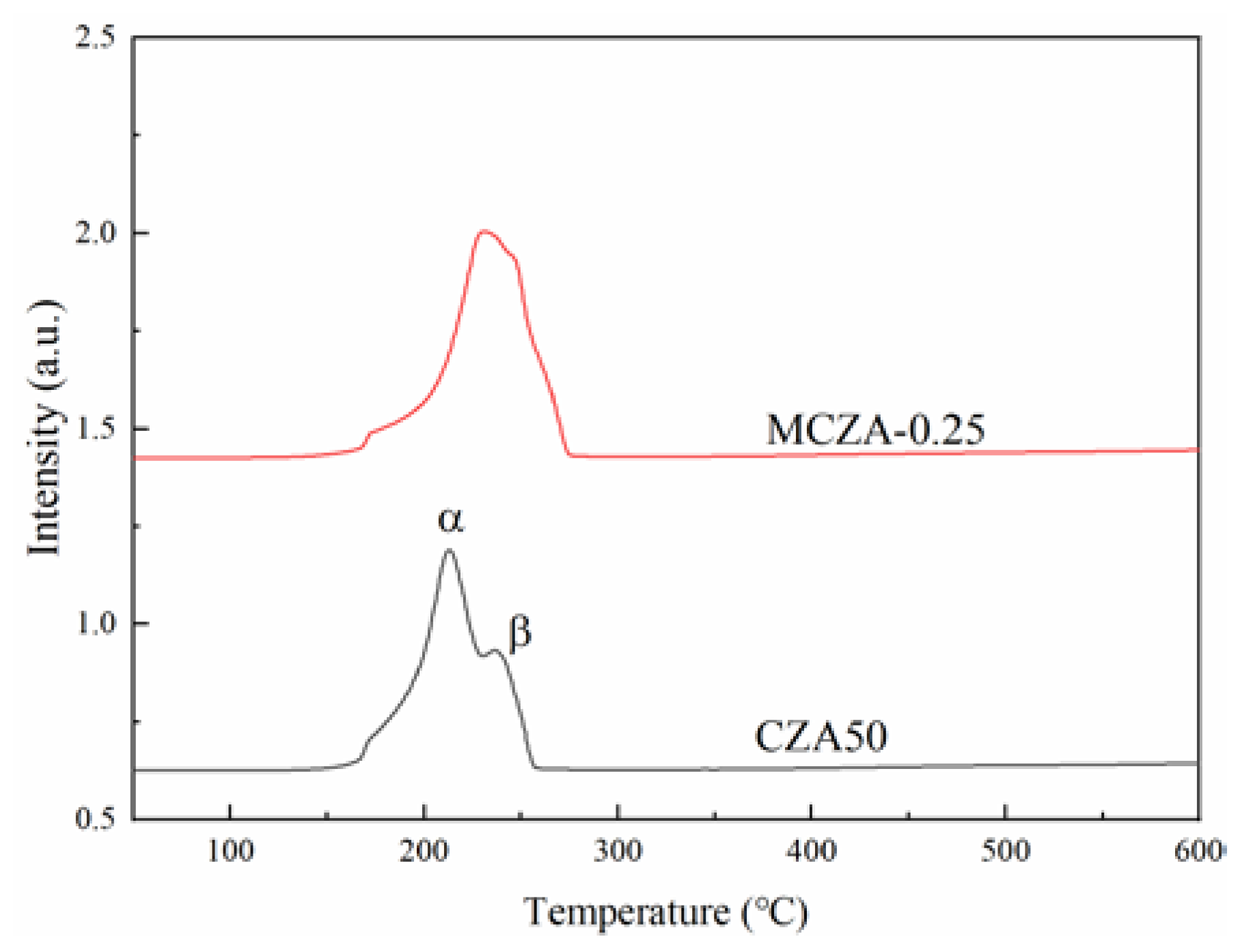
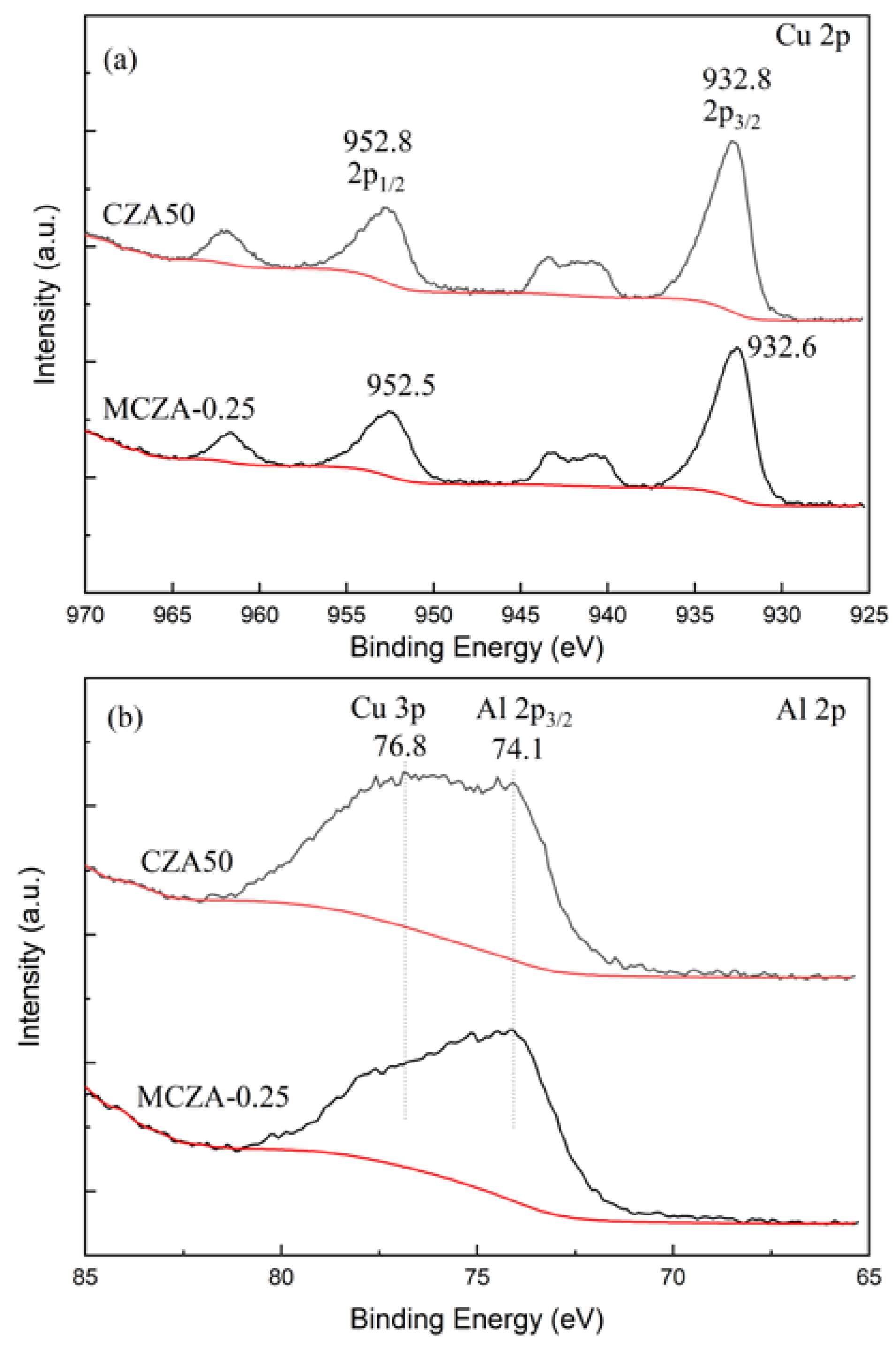
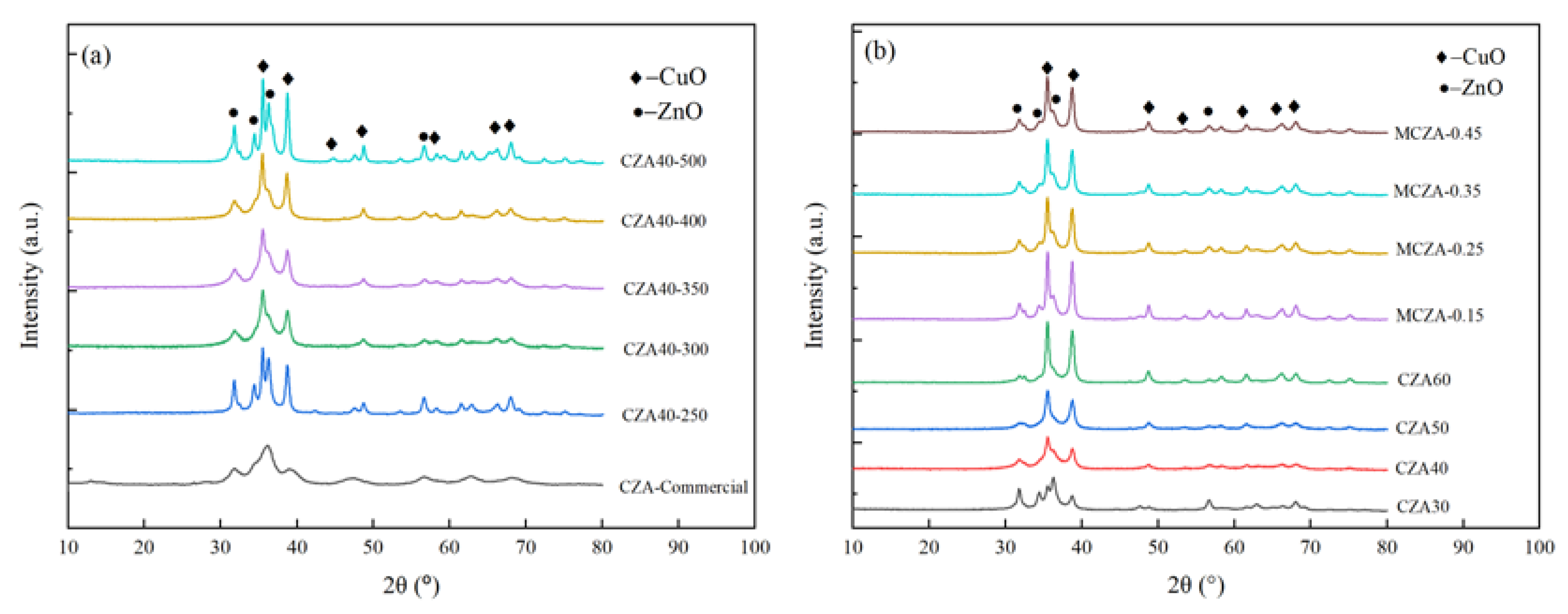


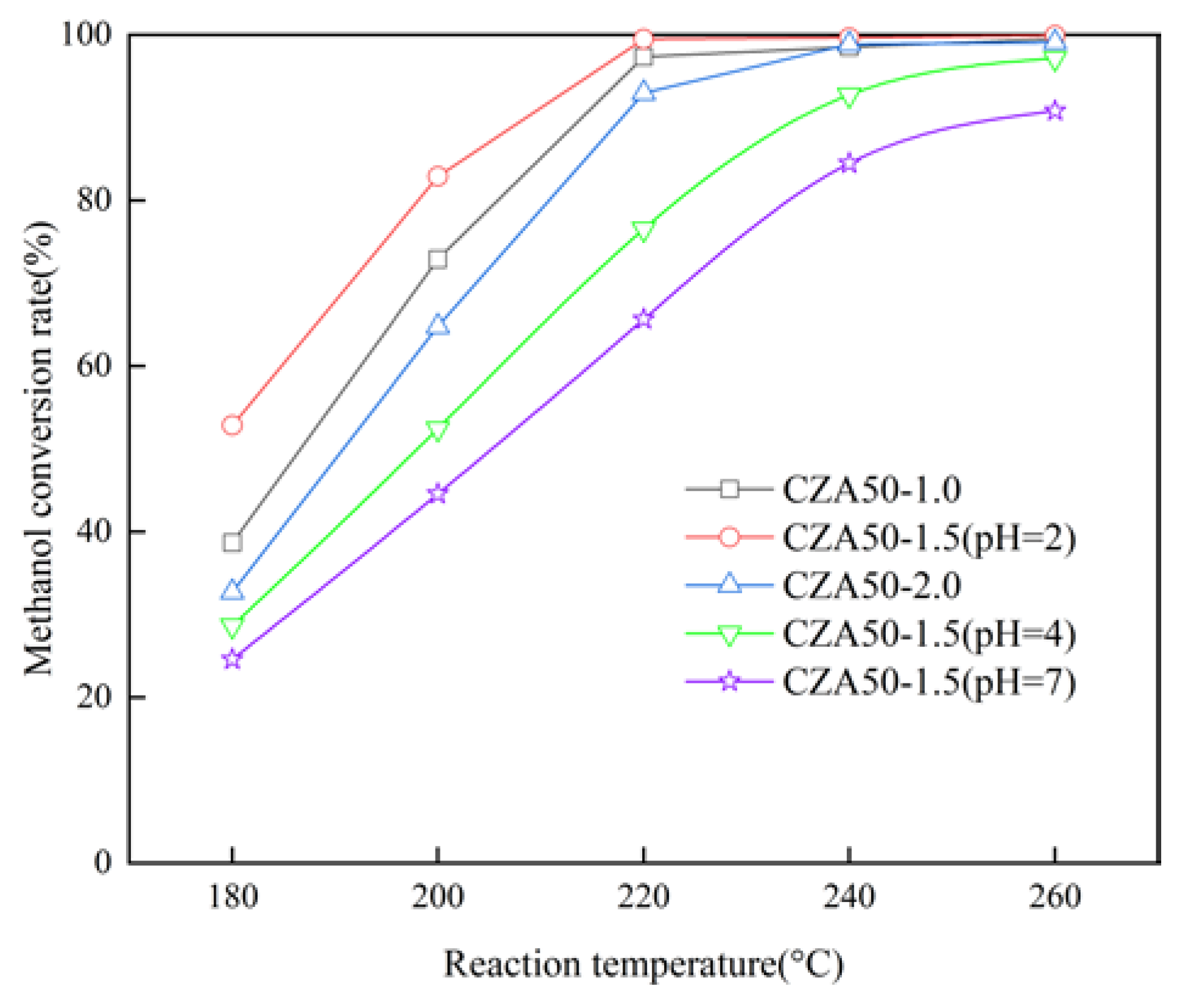


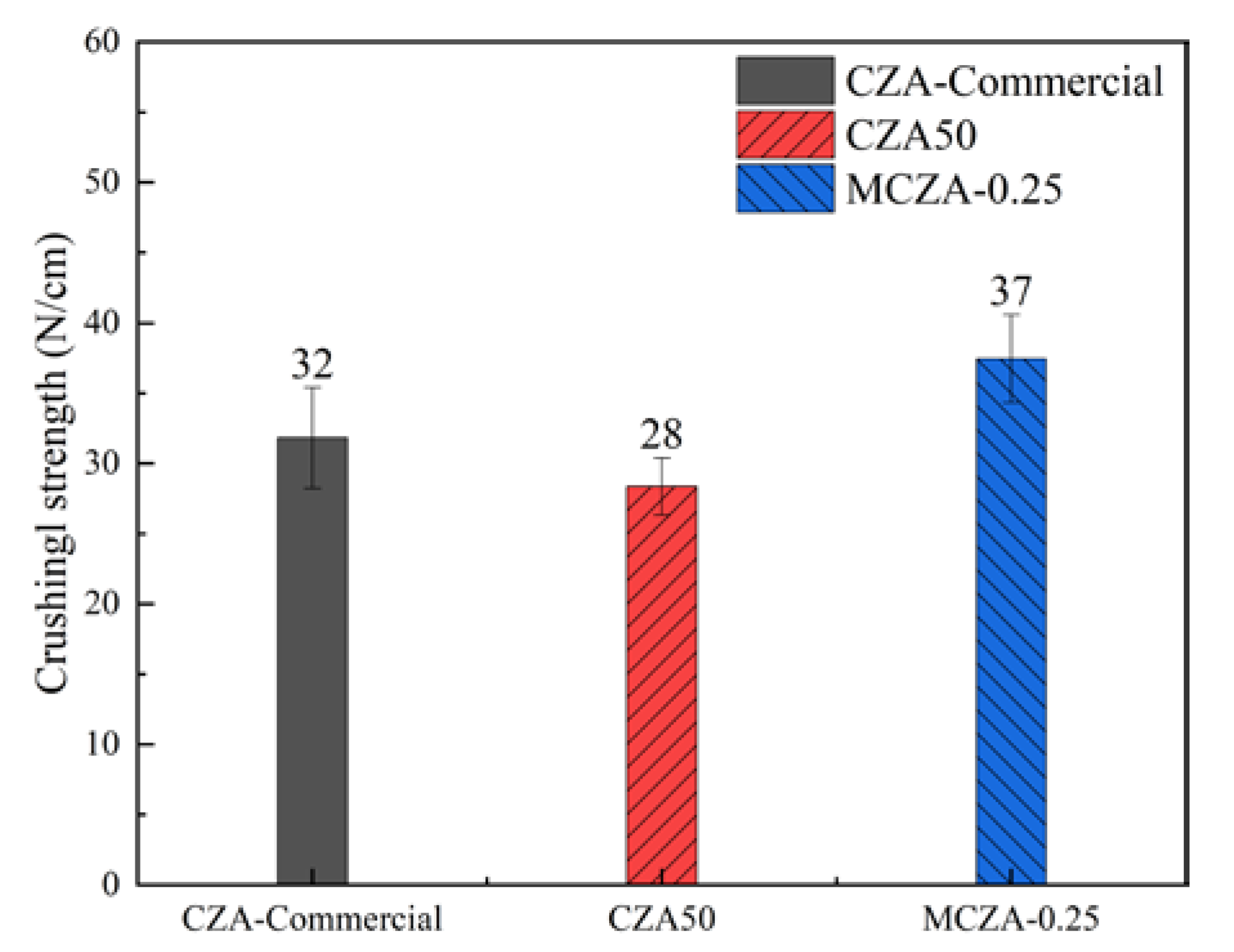

| Samples | The Mole Ratio of Cu: Zn:Al | Weight Fraction of Cu/% | Calcination Temperature/°C | Mole Ratio of Citric Acid to Metal Ions |
|---|---|---|---|---|
| CZA40-250 | 40:40:20 | 38 | 250 | 1.5 |
| CZA40-300 | 40:40:20 | 38 | 300 | 1.5 |
| CZA40-350 | 40:40:20 | 38 | 350 | 1.5 |
| CZA40-400 | 40:40:20 | 38 | 400 | 1.5 |
| CZA40-500 | 40:40:20 | 38 | 500 | 1.5 |
| CZA30 | 30:50:20 | 27 | 350 | 1.5 |
| CZA50 (-1.5) | 50:30:20 | 48 | 350 | 1.5 |
| CZA60 | 60:20:20 | 59 | 350 | 1.5 |
| CZA50-1.0 | 50:30:20 | 48 | 350 | 1.0 |
| CZA50-2.0 | 50:30:20 | 48 | 350 | 2.0 |
| MCZA-0.15 | 50:30:12 | 51 | 350 | 1.5 |
| MCZA-0.25 | 50:30:20 | 48 | 350 | 1.5 |
| MCZA-0.35 | 50:30:28 | 45 | 350 | 1.5 |
| MCZA-0.45 | 50:30:36 | 43 | 350 | 1.5 |
| Samples | Surface Atom Concentration (%) | ||||
|---|---|---|---|---|---|
| Cu | Zn | Al | O | C | |
| CZA50 | 4.6 | 8.5 | 24.4 | 36.7 | 25.8 |
| MCZA-0.25 | 4.1 | 17.5 | 20.2 | 38.1 | 20.1 |
| Samples | Specific Surface Area (m2/g) | CuO Crystal Size (nm) | ZnO Crystal Size (nm) |
|---|---|---|---|
| CZA-250 | - | 31 | 18 |
| CZA-300 | - | 14 | 14 |
| CZA-350 | - | 14 | 15 |
| CZA-500 | - | 17 | 16 |
| CZA30 | 23 | 13 | 14 |
| CZA40 | 62 | 15 | 12 |
| CZA50 | 65 | 15 | 15 |
| CZA60 | 59 | 19 | 21 |
| MCZA-0.15 | 52 | 22 | 21 |
| MCZA-0.25 | 63 | 19 | 16 |
| MCZA-0.35 | 61 | 17 | 15 |
| MCZA-0.45 | 54 | 14 | 14 |
| CZA-Commercial | 99 | 6 | 6 |
Disclaimer/Publisher’s Note: The statements, opinions and data contained in all publications are solely those of the individual author(s) and contributor(s) and not of MDPI and/or the editor(s). MDPI and/or the editor(s) disclaim responsibility for any injury to people or property resulting from any ideas, methods, instructions or products referred to in the content. |
© 2023 by the authors. Licensee MDPI, Basel, Switzerland. This article is an open access article distributed under the terms and conditions of the Creative Commons Attribution (CC BY) license (https://creativecommons.org/licenses/by/4.0/).
Share and Cite
Li, Y.; Luo, C.; Su, Q. Performance of Cu/ZnO/Al2O3 Catalysts Prepared by Sol–Gel Methods on Methanol Steam Reforming. Energies 2023, 16, 7803. https://doi.org/10.3390/en16237803
Li Y, Luo C, Su Q. Performance of Cu/ZnO/Al2O3 Catalysts Prepared by Sol–Gel Methods on Methanol Steam Reforming. Energies. 2023; 16(23):7803. https://doi.org/10.3390/en16237803
Chicago/Turabian StyleLi, Yongsheng, Chunhuan Luo, and Qingquan Su. 2023. "Performance of Cu/ZnO/Al2O3 Catalysts Prepared by Sol–Gel Methods on Methanol Steam Reforming" Energies 16, no. 23: 7803. https://doi.org/10.3390/en16237803
APA StyleLi, Y., Luo, C., & Su, Q. (2023). Performance of Cu/ZnO/Al2O3 Catalysts Prepared by Sol–Gel Methods on Methanol Steam Reforming. Energies, 16(23), 7803. https://doi.org/10.3390/en16237803






